The Aztec empire, known back then as the Mexica, ruled central and southern Mexico for more than 250 years, between 1300 and 1541 AD. The empire brought together, through, trade, force, and tribute, countless different societies from the region of Mesoamerica, creating a melting pot of culture.
Table of Contents
How Many Gods Did the Aztecs Have?
A major part of that culture was its mythology, which included countless, meaning hundreds and hundreds of Aztec gods and goddesses.
Of these hundreds of gods, several stood out as figureheads of ancient Mexican religions. And many are still remembered and worshiped today. Four, in particular, were seen as the most important because they, together, designed the world and placed every other deity in their appropriate realms. The group of brothers is called the Tezcatlipocas.
The four brothers were given birth by Ometecuhtli and Omecihuatl, or the form in which these come together: Ometeotl. All four brothers were responsible for different events that created the universe and life on earth.
Seems like a good start.
Quetzalcoatl: The Creator God
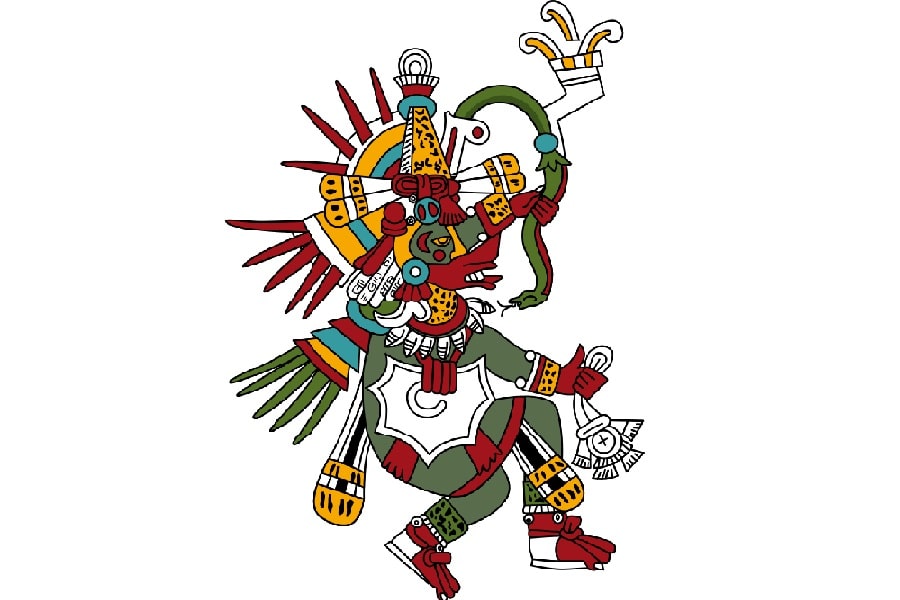
Other Realms: Wisdom, Aztec Priests, Corn, Aztec Calendar, Books.
Parents: Ometecuhtli and Omecihuatl; Siblings: Xolotl and three Tezcatlipocas
Fun Fact: Potentially the only Aztec god who didn’t require human sacrifices
Nicknames: Feathered Serpent, White Tezcatlipoca, Supreme God
Quetzalcoatl, better known as the Feathered Serpent, was one of the most important Aztec gods and a jack of all trades. He is seen as the very god that gave life to (the Aztec) people.
So, how did he do it? This is connected to the sun cycles of Aztec mythology. According to the Aztecs, the second and fifth coming of the sun were realized thanks to potentially the most important Aztec god of all, Quetzalcoatl.
While former life on earth vanished because of the fourth eclipse, the realm of gods was still alive and kicking. Well, at least partly. Quetzalcoatl is often held responsible for the remaking of life after the eclipse. After the fourth eclipse, this would include human life for the first time in Aztec history.
He did so by making a trip to the underworld. Here, the Feathered Serpent entered Mictlan, the deepest level of the Aztec underworld, where he gathered the bones of all the previous races that walked the earth.
By adding a bit of his own blood, he allowed a civilization of new creatures to emerge. Since he basically allowed people to live after the fourth eclipse, he is seen as the personification of the fifth sun. Or, rather, the first installment of human civilization.
The Feathered Serpent is, however, much more than that. It was believed that he’d occasionally leave the earth and come back in a new shape, eventually leading to his transformation from a feathered serpent to something more human-like.
Because of his reincarnation, he is also seen as the god of knowledge and wisdom, the god of corn, and the god of the priesthood, amongst others.
READ MORE: Quetzalcoatl: The Feathered Serpent Deity of Ancient Mesoamerica
Huitzilopochtli: The Aztec God of War and Sun God

Other realms: Aztec sun god, human sacrifice, patron of Tetihuácan
Parents: Ometecuhtli and Omecihuatl; Siblings: Quetzalcoatl and two other Tezcatlipocas
Nickname: Blue Tezcatlipoca
Fun fact: Was so bright that he could only be seen when using a shield for sun protection
The temple at Tetihuácan is one of the first representations of Quetzalcoatl. Also, it’s one of the most prominent examples of pyramids in America. Early depictions at Tetihuácan usually show two snake gods: one looking inward to the city (Quetzalcoatl) and the other looking outward. The one looking outward is one of the other Aztec gods, known as Huitzilopochtli.
So, why is it significant that he is looking outward? It stands for the outward expansion of the Aztec empire. In a culture known for its violence and expansion, Huitzilpochtli also makes a good case for the most important Aztec god.
In any case, he is definitely the most important war god if taking into account all Aztec deities. More particularly, he was the patron god of war. That means that he is responsible for the victories as well as the losses. To honor the fallen warriors, people would pray and offer to Huitzilopochtli.
But, of course, it wasn’t his fault that people would lose the war. Rather, he would be offered more sacrifices. While his brother Quetzalcoatl didn’t accept human sacrifices in any form, Huitzilopochtli was quite the opposite. In fact, he is sometimes considered to be the god of human sacrifice.
On the brighter side, Aztec god Huitzilopochtli is also believed to be the Aztec sun god. Together with his brother Quetzalcoatl, he was tasked to bring order to the world.
While his brother created an ancient civilization, Huizilpochtli was responsible for one of the other three suns. He was in constant battle just to keep the sun up in the sky, something in which his warlike spirit came in very handy.
The biggest temple of Huizilopochtli can be found at Templo Mayor, next to Tlaloc’s main shrine.
Tezcatlipoca: The Aztec God of Providence
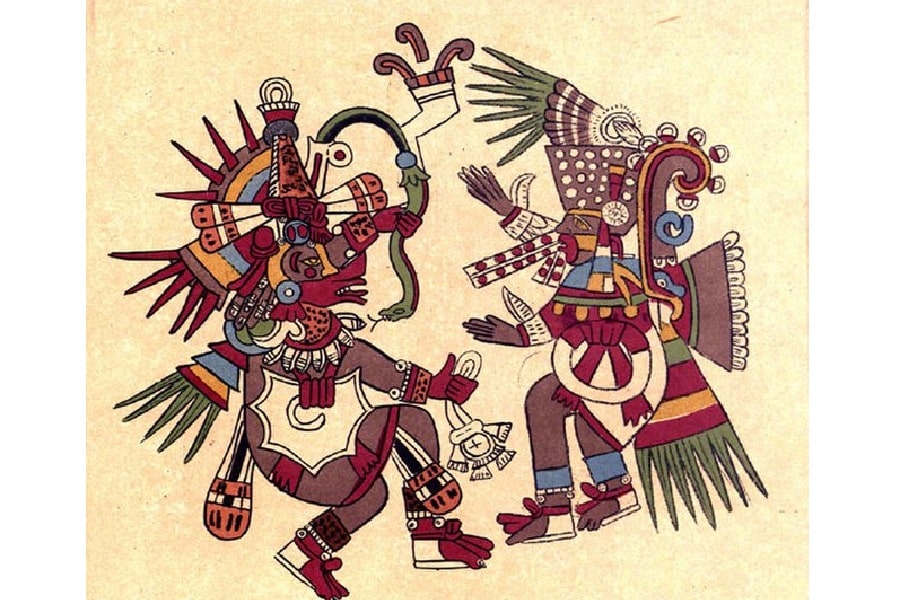
Other realms: Nocturnal sky, beauty, the North
Parents: Ometecuhtli and Omecihuatl; Siblings: the other three Tezcatlipocas
Nickname: Black Tezcatlipoca, Obsidian Mirror, Smoking Mirror
Now, things get confusing. Well, Aztec mythology will probably always be confusing for the average reader. Either way, in this instance it gets confusing because the second child of Ometecuhtli and Omecihuatl carries the same name as how we refer to the four brothers together.
Indeed, that will be Tezcatlipoca. He was the one that created the first Sun, and therefore the god of life, the creator of the first life on earth. Life, that is, not your everyday human life. His form of life had more to do with a race of giants.
As we saw, his brothers also play a vital role in the creation of suns. Because Tezcatlipoca was the first sun, the groups of brothers that created the suns would be called after the pioneering brother.
Tezcatlipoca is associated with many different things, including the night sky, the north, hostility, and leadership. The Aztec god, too, is also referred to as the Smoking Mirror or obsidian mirror because he was often depicted with one of those as one of his attributes. This obsidian mirror allowed him to see clearly at night.
In any interpretation of the myth, Tezcatlipoca didn’t have a good relationship with Quetzalcoatl. In fact, they were fighting more often than not. Both were seen as instrumental to the creation of life, and some even argue that Tezcatlipoca originally was the one that ought to give life to people. However, his brother Quetzalcoatl stopped him in the process and did it himself.
Exactly this idea of conflict is also something that the Aztecs related to Tezcatlipoca. More than anything, Tezcatlipoca appears to be the embodiment of change through conflict.
Xipe Totec: The Aztec God of Agriculture and Rituals
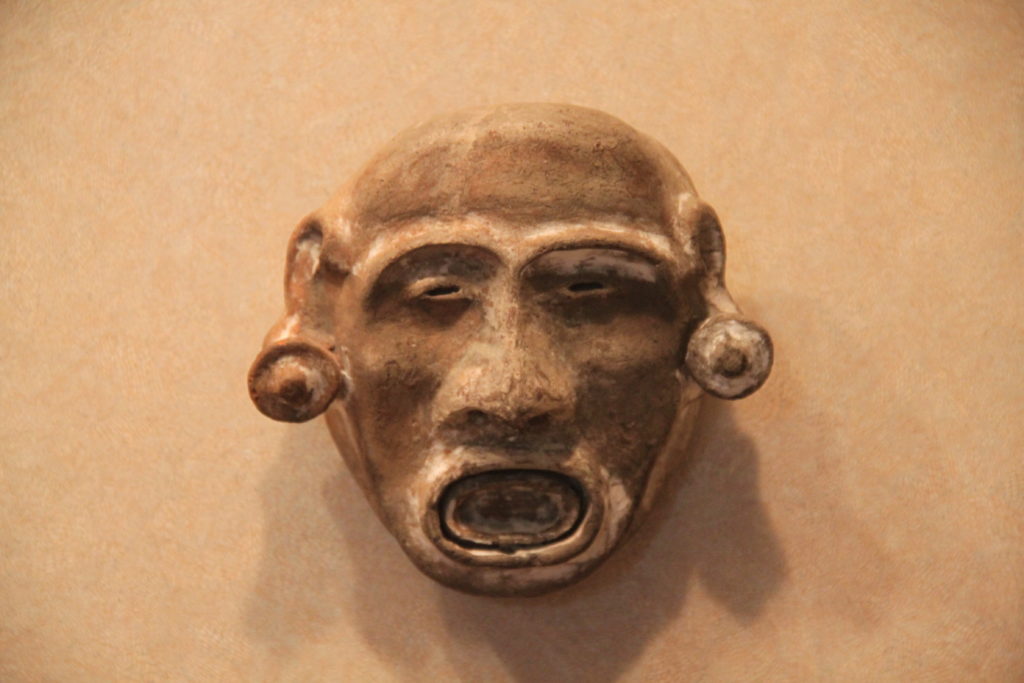
Other realms: Life and death, warfare, maize
Parents: Ometecuhtli and Omecihuatl; Siblings: the other three Tezcatlipocas
Nicknames: Red Tezcatlipoca, Camaxtli, Oamaxtli, Camaxtle, Xipe, Flayed One
The last of the four important Aztec gods that gave birth to Omethecuhtli and Omecihuatl is named Xipe Totec, or the Red Tezcatlipoca. Xipe Totec was born first, somewhat functioning as a mentor and mediator for all of his other brothers. With his flayed human skin, the ‘Flayed One‘ would be of great but mostly unnoticed importance compared to his brothers.
Xipe Totec is connected with agriculture and rituals, but also with agricultural renewal and warfare. Also, he gave food to all the human beings on earth, which was believed to be demonstrated in the way maize seeds lose their outer layer before their germination.
Besides that, Xipe Totec was the very Aztec god that invented war, which is affirmed by the attributes he is often depicted with: a pointed cap and rattle staff.
Xipe Totec was usually presented wearing flayed human skin symbolizing the death of the old and the growth of new vegetation. Sometimes it is believed that the Aztec god flayed his own skin to feed humanity.
Tlaltecuhtli: The Aztec God of the Earth
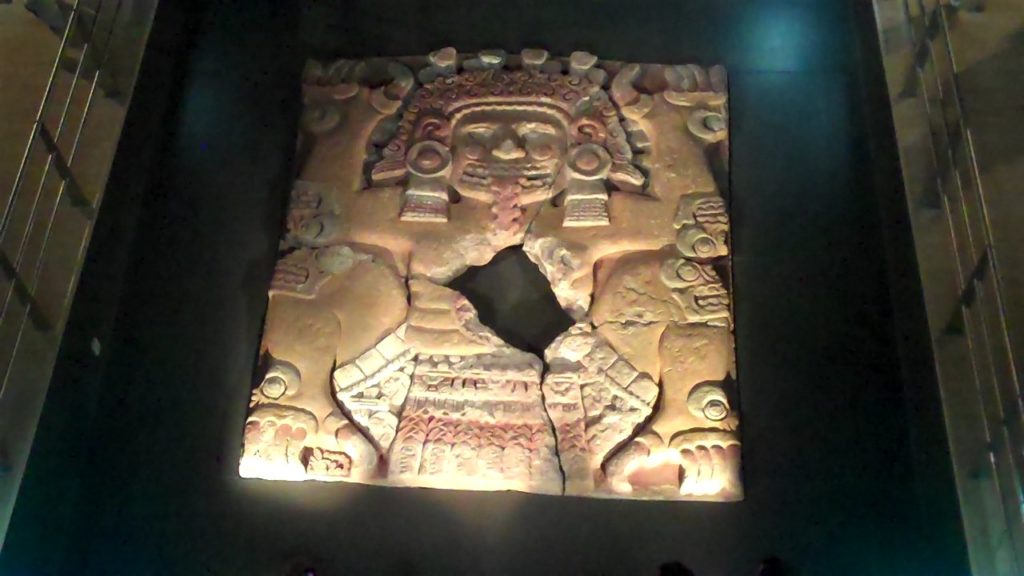
Family: Created by the Tezcatlipocas
Nicknames: Lord of the Earth, Earth Monster
After the cornerstones for life and society were created, the Tezcatlipocas had to create all the realms and share them among all other gods. Which they also created.
One of the first Aztec gods and goddesses they created goes by the name of Tlaltecuhtli, or the ‘earth monster’. The Aztecs believed that the body of the god was the basis of planet earth in its latest creation.
Furthermore, the Aztecs believed that Quetzalcoatl and Tezcatlipoca created a purely liquid world at first. Of course, this couldn’t be properly inhabited. Therefore, they brought down Tlacihuatl and Tlaltecuhtli to become the earth. It’s might sound a bit unorthodox, but this part of Aztec religion played a big role in the respect for the earth that Aztecs were known for.
Templo Mayor was one of the places where a colossal representation of Tlatecuhtli can be found. It’s quite indicative of the importance of Tlaltecuhtli since Templo Mayor was the great temple of the capital city of the Aztec kingdom, Tenochtitlan.
As with many other Aztec gods and goddesses, Tlatecuhtli’s temper was controlled through human sacrifices. Only this would ensure the continued order of the earth and the ecosystem it represents.
Tlaloc: The Aztec Rain God
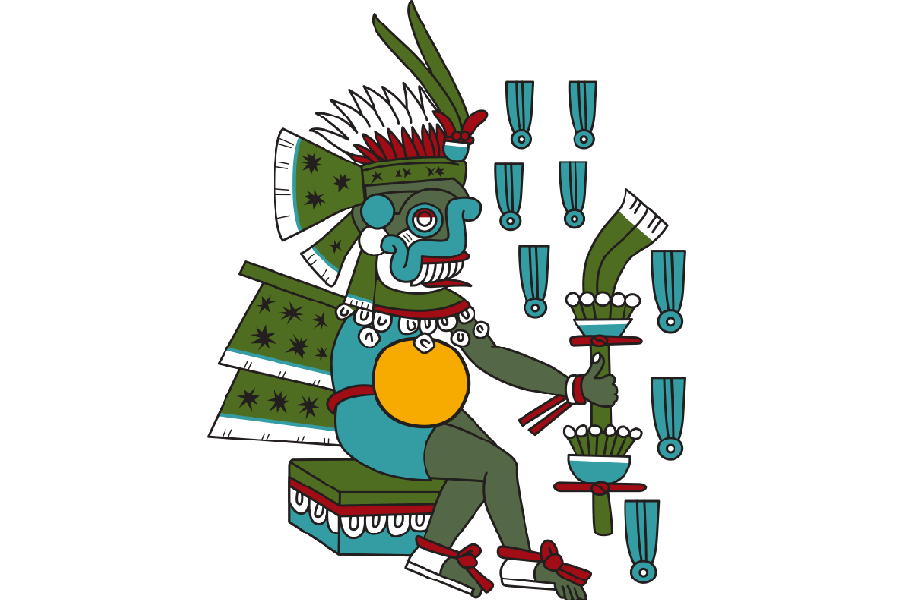
Other realms: Earthly fertility, Agricultural fertility, Water
Family: Created by the Tezcatlipocas
Fun fact: Had a three-week-long festival in which children were sacrificed to him. Yikes.
In Aztec religion, Tlaloc is the rain and water god and is worshiped as the one that gives life to the earth and establishes agricultural fertility. He existed way before the Aztecs started to worship him. In the earlier myths, he is believed to be the creator of Quetzalcoatl. In the myths of the Aztecs, however, the roles would rather be the other way around.
As a rain god, it’s not hard to understand that Tlaloc is associated with water springs and lakes. But what were his relationships with mountains, caves, thunder, and lightning?
READ MORE: Who Invented Water? History of the Water Molecule
Well, mountains and caves were the place where he resided: a cave in mount Tlaloc. Lightning and thunder were his tools to punish people for a lack of worship. He would also use floods and hail, but lightning and thunder were specifically for individuals that displeased him.
The different roles of the Aztec god Tlaloc aren’t uncommon in Aztec mythology. In fact, it is quite normal that Aztec gods are seen and named differently from time to time. But, they can still be manifestations of the same god. This could also be seen in the four most important Aztec gods as earlier described.
The baseline is that Tlaloc was a highly respected Aztec god, which is affirmed by the fact that Tlaloc’s main shrine sat at the top of Templo Mayor.
Mictlāntēcutli: The God of the Dead

Family: Created by the Tezcatlipocas
Nicknames: Broken Face, Scatterrer of Ashes, He Who Lowers His Head
Fun fact: Tried to stop Quetzalcoatl from remaking civilization but fumbled the bag.
The story about the Aztec gods had to take a sinister turn at one point, especially with Aztec mythology and Aztec culture being so notorious for human sacrifice and blood sacrifice. This is where Mictlantecuhtli enters the playing field, sometimes quite literally.
Mictlāntēcutli is the Aztec god of death, king of Mictlan. Mictlan is the realm where Quetzalcoatl went and revived human civilizations. The deepest part of the underworld, that is, and Mictlāntēcutli was in charge. There are several Aztec gods and goddesses of the underworld, but Mictlāntēcutli is the most prominent one.
His worship involved ritual cannibalism, with the ancient Aztecs eating human flesh in and around his temples.
Mictēcacihuātl: The Lady of the Dead
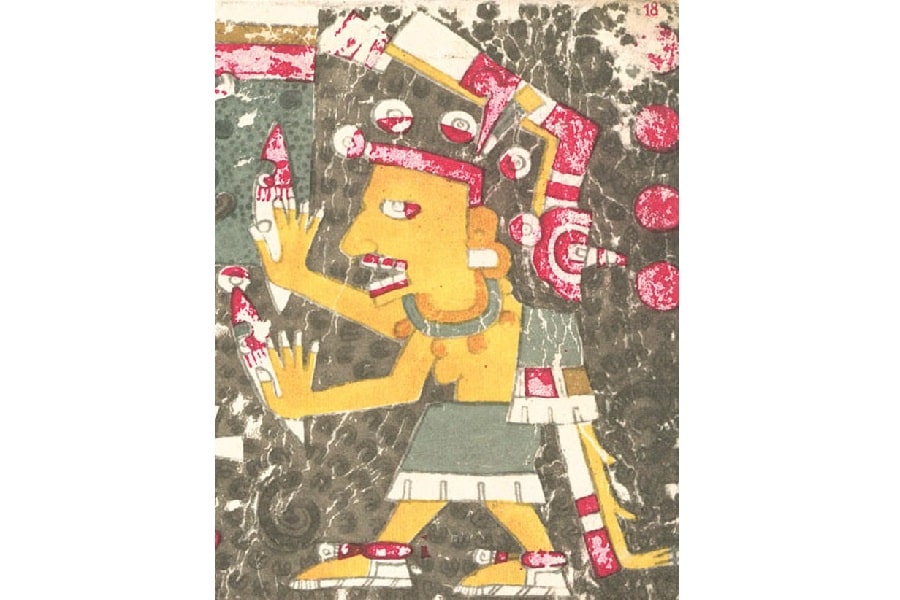
Other realms: Innocent deaths
Fun Fact: Potentially still worshiped today in the form of Nuestra Señora de la Santa Muerte
Mictlāntēcutli was but one of the many Aztec gods and goddesses that ruled the underworld. Another evil power almost had the same name, Mictēcacihuātl. Indeed, she was the consort of the god of the dead and co-ruled the lowest level of the underworld with him.
The role of Mictēcacihuātl was to watch over the bones of the people that had died, for reasons that are mostly unknown. The most sinister of Aztec deities also had a joyful side to her, however.
She presided over the ancient festival of the dead. Today she is known as Nuestra Señora de la Santa Muerte. A festival dedicated to this deity, Dia de la Muerta, is still widely celebrated in Mesoamerican cultures and takes place on November 1st.
One name that is often used when referring to her is ‘Lady of the Dead’. The goddess got this name after she was sacrificed upon birth. The sacrificial blood was believed to make the god of the dead content, which seems to be the case. Many of her depictions are painted red to represent this blood.
Xolotl: The Aztec God of Fire
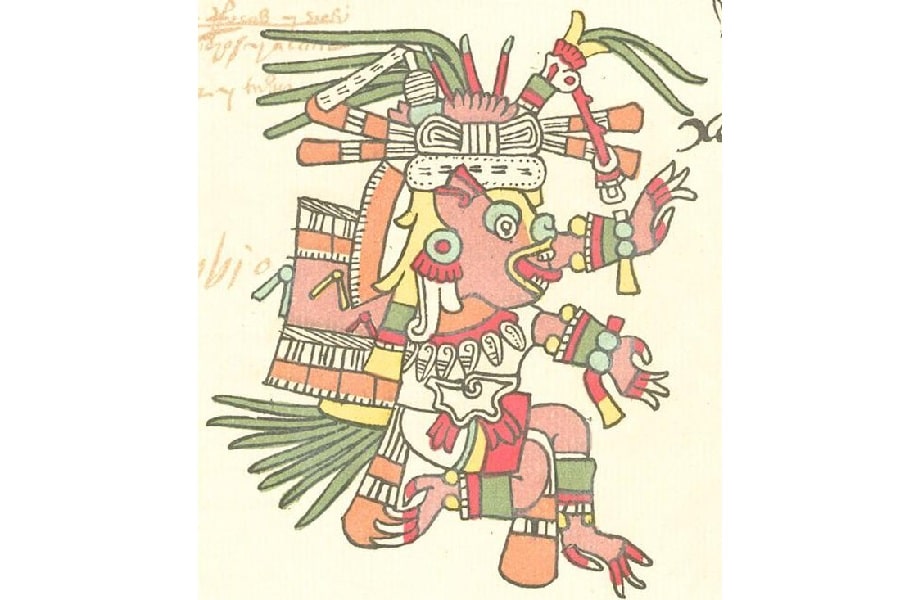
Other realms: Twilight, Twins, Monsters, Misfortune, Sickness, Deformities
Family: Quetzalcoatl, parents Mixcoatl and Chimalma
Nicknames: Evil Twin, Xoloitzcuintle, Xolo
Generally, Xolotl was related to fire and lightning, showing some overlap with the realm of Tlaloc.
However, he is also considered to be the twin brother of Quetzalcoatl. While his brother is often referred to as the morning star, Xolotl is the personification of the planet Venus: the evening star. Being an Aztec god that is related to the evening and night comes with its perks. Well, it actually depends on how you would define a perk.
The job of Xolotl was mainly to protect the sun, his brother, from the dangers of the underworld. Therefore, he was basically the bodyguard of Quetzalcoatl when he went to the underworld to gather the bones for the start of a new civilization.
As the personification of the evening, it is believed that Xolotl accompanies Quetzalcoatl every night through the underworld and protects him. This means that the Aztecs believed that the sun went to the underworld at night. Indeed, going to the underworld was not just a one-time occurrence. It is a daily encounter and plays an important role in overall Aztec mythology.
Mixcoatl: The Aztec God of Hunt

Other realms: Milky way, stars, fire
Nicknames: Itzac-Mixcoatl, Camaxtli, Camaxtle
While the Aztec diet was mainly vegetarian, hunting still played an important role. Not for the least because it provided meat that could be offered to the gods. But also, just to eat. The god of the hunt is known as Mixcoatl.
He would make a name for himself by being the first one that struck fire with flint. Because of this, he is so thoroughly related to war, fallen warriors, the hunt, and the Milky Way.
While the hunt was important, even more, important was their knowledge of astrology. It is hard to grasp how much the Aztecs actually knew about our universe. However, it is part and parcel of Aztec mythology and thoroughly related to the most important Aztec god. Mixcoatl was believed to be the patron of astrology, enforcing his important position in Aztec mythology.
Sometimes, Mixcoatl is mixed up with the ‘Smoking Mirror’ Tezcatlipoca. There is a good reason for this because the Smoking Mirror once transformed himself into a new deity that turned out to be Mixcoatl. Luckily for Mixcoatl, Smoking Mirror allowed him to exist on his own terms after, creating a whole new deity.
Coatlicue: The Mother of the Gods
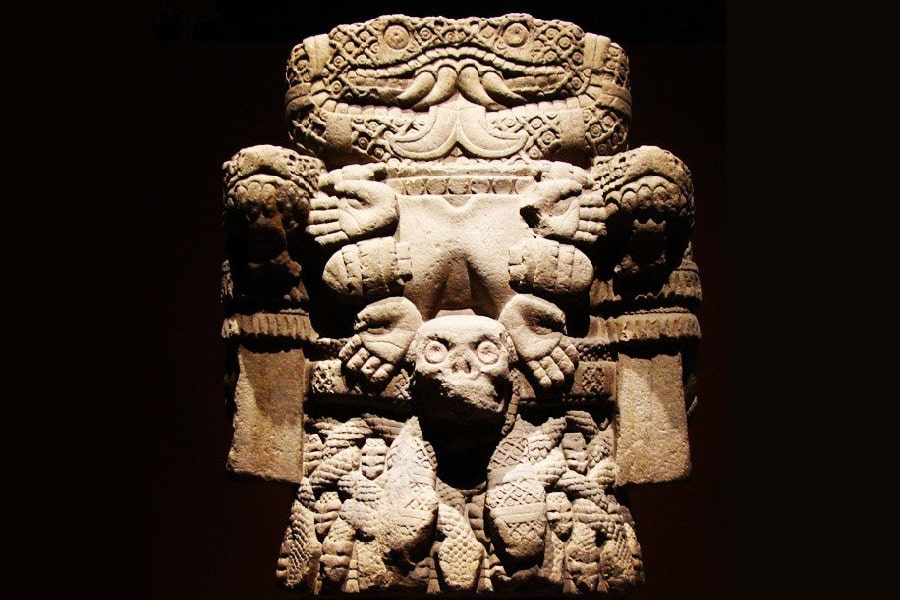
Other realms: Fertility, patron goddess of life and death, guide of rebirth
Parents: Tlaltecuhtli and Tlalcihuatl; Siblings: Chimalma dn Xochitlicue
Nicknames: Our Mother, Snake Woman, Serpent Skirt, Old Mistress, Corn Tassel Necklace
The first Aztec goddess that we discuss goes by the name of Coatlicue. Generally, the Aztec goddess is considered to be the mother of gods. And, probably the most important snake goddess, which explains her nickname the Serpent Skirt.
Apart from being the mother of the gods, she is also considered to be the fertility goddess and wears a serpent skirt. Wearing a serpent skirt, or serpent skin in general is related to fertility in the Aztec religion.
Technically, she wasn’t the mother of all Aztec gods. But, she was the mother of the god Huitzilpochtli before he became one of the Tezcatlipocas. She is also considered to be the one who gave birth to the moon and the stars, celestial bodies that are often related to the gods of the Aztec empire.
The Aztec goddess would, too, prophesize the fall of the Aztec empire. As the mother of the Aztec sun god and war god, she was more than able to do so.
Coyolxāuhqui: The Leader of the Centzon Huitznahua

Parents: Coatlicue, Mixcoatl; Siblings: Huitzilpochtli and the Centzon Huitznahua
Fun Fact: Was only discovered in 1970 when building a skyscraper in Mexico City.
One of the first children of Coatlicue was Coyolxāuhqui. This Aztec goddess is believed to be the leader of her brothers, which are also referred to as Centzon Huitznahua.
Although the Serpent Skirt was their mother, they didn’t really like her. Coyolxāuhqui led her brother in an attack on their mother because she got pregnant, again. Her miraculous pregnancy embarrassed Coyolxāuhqui and the crew, which made them decide to kill her as a form of punishment. However, the Aztec god that she was pregnant with was Huitzilpochtli.
While still in the womb, Huitzilpochtli, who later became one of the most important gods, warned Coatlicue of the attack. After being informed, Coatlicue miraculously gave birth to Huitzilopochtli. Her newborn child shielded her from the attack coming her way.
Some believe that Coyolxāuhqui was beheaded in this battle, after which her head became the moon in the sky.
Mayahuel: A Personification of Maguey
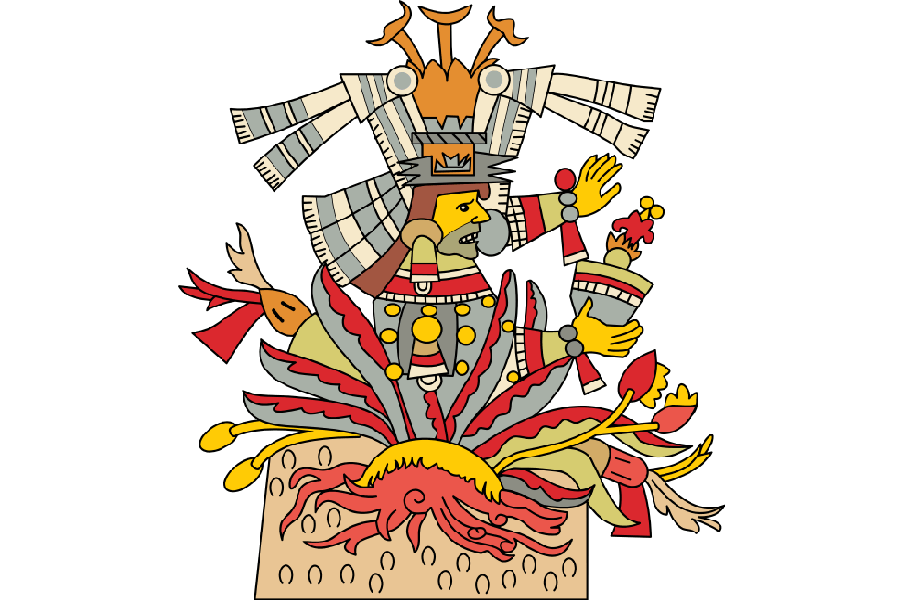
Other realms: Fertility, alcohol
Family: Omecihuatl, Nauhtzonteteo
Fun fact: Also referred to as the goddess of alcohol
Mayahuel is another female Aztec deity and is related to the maguey plant. It’s a plant that is part of the agave family and is regarded to be one of the most healing plants of all. She isn’t really the Aztec goddess of the plant. Rather, she is the personification of it.
With the maguey as her base, Mayahuel is also related to the realm of fertility and connected with notions of fecundity and nourishment.
The plant is still today widely used in Mesoamerican cultures. For example, its leaves are woven into ropes, bags, and clothes. In ancient cultures, however, thorns were used to retrieve sacrificial blood from ancient Aztecs.
But, the most famous use is to make pulque: a classic Mexican alcoholic beverage still used in Mesoamerican cultures.
Chantico: The Goddess of Family Fire
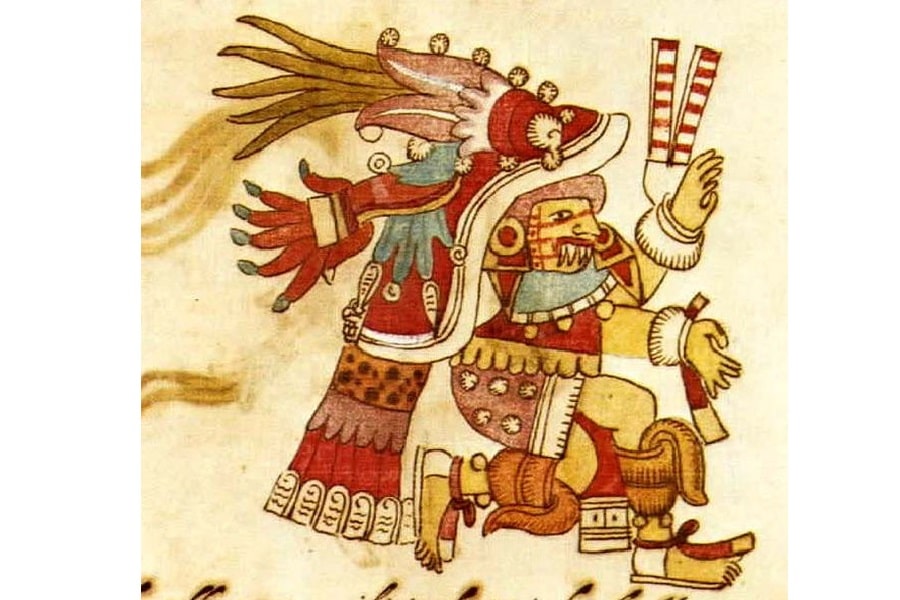
Nicknames: Chiconaui, Quaxolotl
Fun fact: While normally referred to as female, its gender isn’t actually certain
Chantico was the Aztec goddess that reigned over the fires in the family hearth. So basically, she was the one who held the family together, the glue. This is also very evident from her name, which can literally be translated to ‘she who dwells in the house’.
There is a big stain on her legacy, however. Or it could also be seen as part of her legacy. While she was meant to fast during a festive period, she ate paprika with roasted fish. A meal that only a few can resist.
After doing so, she was punished by other Aztec gods and goddesses, which turned her into a dog. It is believed that people that are born on the day Chantico turned into a dog would encounter lifelong misfortune.
All of her face and attributes are painted red to represent the blood that is related to this misfortune. Indeed, the misfortune would often be that they were born in a which was more prone to become a human sacrifice.
Tonatiuh: The Fifth Sun
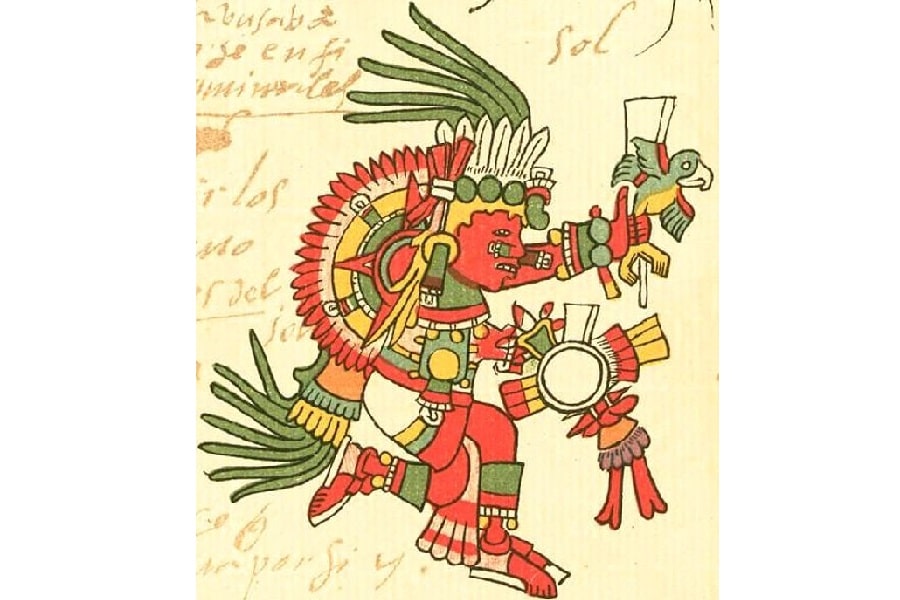
Other realms: Daytime and ‘the east’
Family: Quetzalcoatl
Nicknames: Movement of the Sun, 4 Movement
While Quetzalcoatl and his brothers manifested civilization after the fourth eclipse, Tonatiuh is referred to as the Fifth Sun. This is mainly because he caused the movement of the sun. Indeed, he was not the sun itself, but rather the movement thereof.
Tonatiuh ruled over the daytime sky, allowing the sun to come up in the east and go under in the west. He was a fierce and warlike Aztec god, associated with the eagle.
Because of his importance for the daytime, Tonatiuh was formerly believed to be the central deity of the Aztec calendar stone. Later, it would become clear that this was probably Tlaltecuthli.
The depictions of Tonatiuh in the Aztec capital city were ample, which made researchers believe that he was one of the most important Aztec gods.
Furthermore, when the Spanish tried to conquer the Aztec empire, the Aztecs believed that Tonatiuh could be reincarnated as one of the conquistadores. More specifically, it was believed that Tonatiuh would be a white man with a red beard, which fitted the cadence of Pedro de Alvarado.
Xochipilli: The Patron God of Writing and Painting
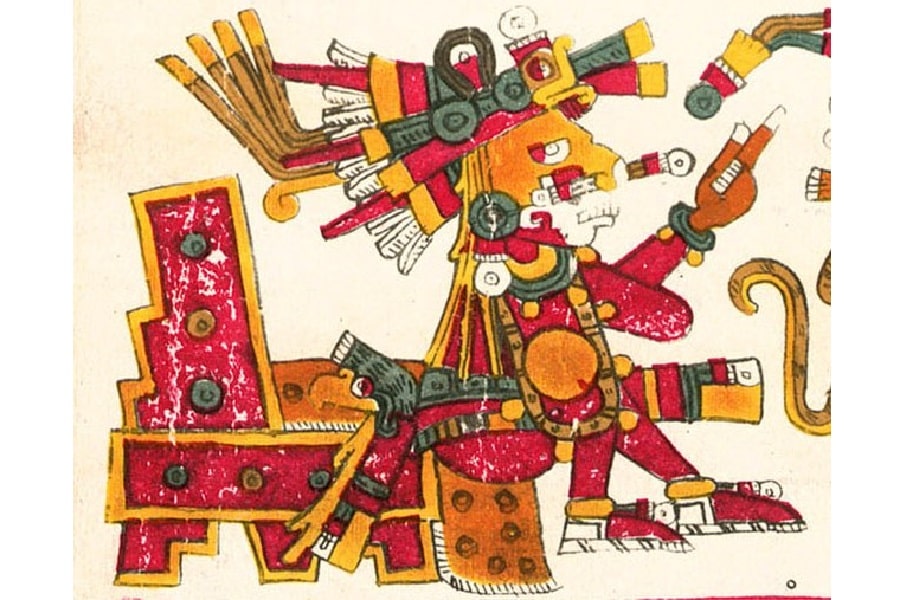
Family: Xochilicue, Xochiquetzal
Nicknames: Chicomexōchitl, Macuilxōchitl
Fun Fact: Could very well be the first saint to be open to homosexuality
The next Aztec god is the most creative one thus far. The Aztecs believed Xochipilli to be the patron of writing and painting. Some of his nicknames translate to ‘Seven-Flower’ or ‘Fifth-Flower’. Since flowers are thoroughly related to creativity and our ability to see color, these nicknames affirm his creative aspect.
He is also seen as the inventor of one of the oldest games known to men: patolli. Oftentimes he is depicted wearing a talisman, decorating his neck.
For some, it might be unexpected, but the Aztec culture was actually quite open toward homosexuality and (male) prostitution. Xochipilli is believed to be the patron of both of these realms.
Some also believe that the way in which he is depicted indicated that he was an advocate of psychoactive substances, helping him to reach his full creative potential.
Chalchiuhtlicue: The Aztec Goddess of Water and Baptism

Other realms: Lakes, Rivers, Jade
Family: Created by the Tezcatlipocas
Nicknames: Jade Skirt, She who shines like Jade, Possessor of the blue skirt
There are many Aztec water deities and the most important among them is Chalchiuhtlicue, the goddess of life-giving waters, rivers, and seas. Her name translates as ‘she who wears a jade skirt.’
Besides water, she is also related to fertility and is considered to be the protector of children and women during childbirth.
Xiuhtecuhtli: The Aztec God of Heat
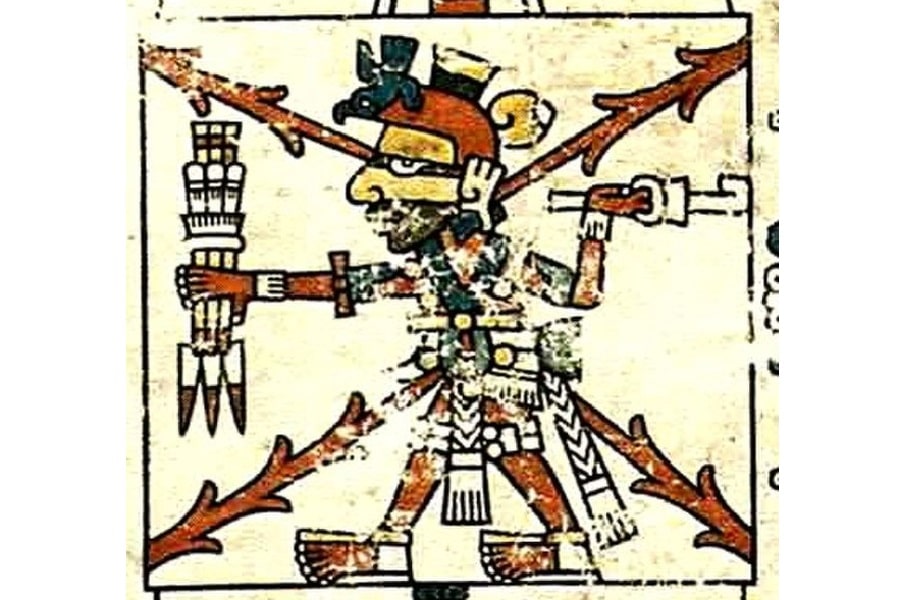
Other realms: Volcanos, life after death
Nicknames: Turquoise lord, Lord of Fire, The Old God, Lord of Volcanoes.
Family: Created by the Tezcatlipocas
Next in line of the supernatural beings subjected to Aztec worship is Xiuhtecuhtli, the god of heat, the personification of life after death, lord of volcanoes. How badass must one be to be called the ‘lord of volcanoes’?
Well, Xiuhtecuhtli was exactly that. Xiuhtecuhtli is often mixed up with other Aztec gods, like Huehuetetl and Ometecuhtli. These two are considered to be the ‘old god’ and the ‘lord of duality’.
That’s not a coincidence. The ones that he is often confused with are two gods considered to be the oldest and most revered of Aztec gods and goddesses. Xiuhtecuhtli, too, was rather old and archeologists had to dig deep into the ancestral memory to uncover him. Probably that’s why the Aztecs and scientists mix him up more often than not.
Purely based on his name, he would be referred to as the ‘year of fire’, but also the god of the year and of time. He was regarded as the Aztec god of time because the Aztecs believed that he was the North Star, a highly important star if one wants to understand astrology.
Ehecatl: The God of the Wind
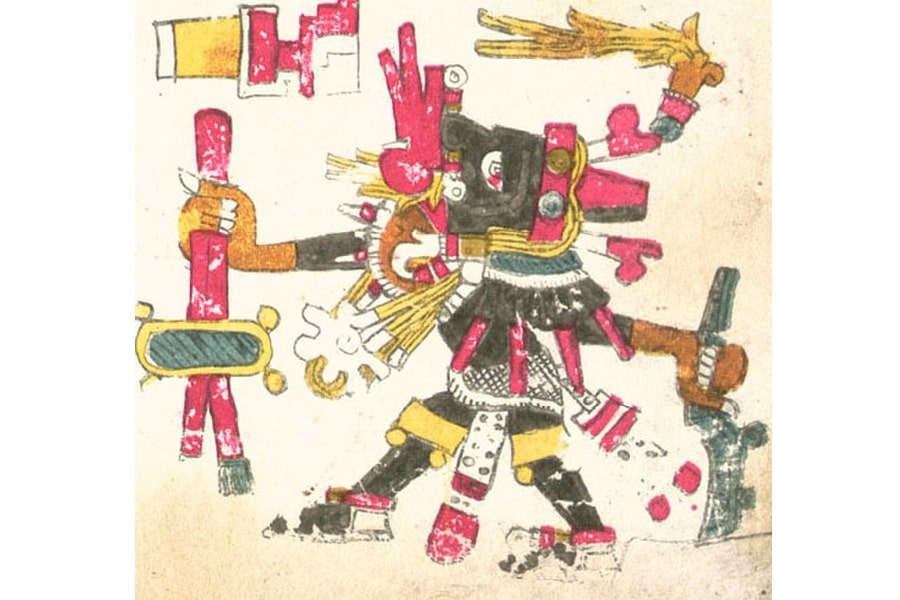
Fun fact: Also believed to be the second day of the Aztec calendar
The next among the Aztec gods and goddesses is Ehecatl, a deity associated with the wind. His features are derived both from Aztec mythology and other cultures from central Mexico. He carries characteristics from the Feathered Serpent, which gives him one of his nicknames: Ehecatl-Quetzalcoatl.
While all four Tezcatlapoca brothers were associated with one cardinal direction in particular, Ehecatl was related to all of them. One great temple was dedicated to him, which was built in a way of self-reflection. Or rather, self-definition.
That is to say, his temple had a cylinder form. This form allows for the least amount of air resistance. While the other temples, mostly pyramids, were subjected to the wind, the temple of Ehecatl wasn’t. That’s because he was the wind himself.
Chicomecoatl: The Goddess of Corn
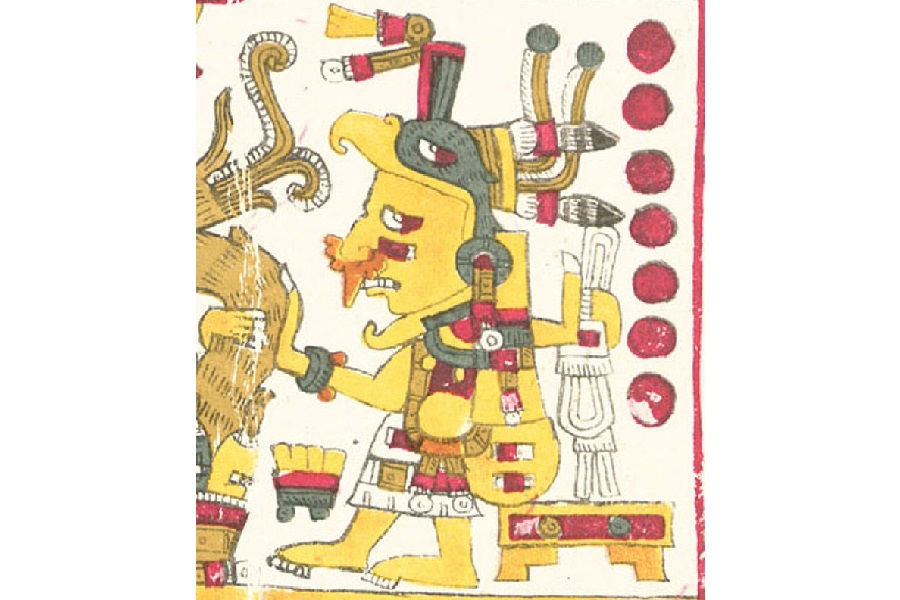
Other realms: agriculture, human livelihood
Nicknames: Seven Serpent
One goddess that was related to fertility is called Chicomecoatl. While both Quetzalcoatl and Tezcatlpoca represented the fertility of the earth as gods, Chicomecoatl was their female counterpart. She was especially related to the female fertility aspect of maize, but more generally to food, drink, and human livelihood.
Centeotl: The God of Maintaining Corn
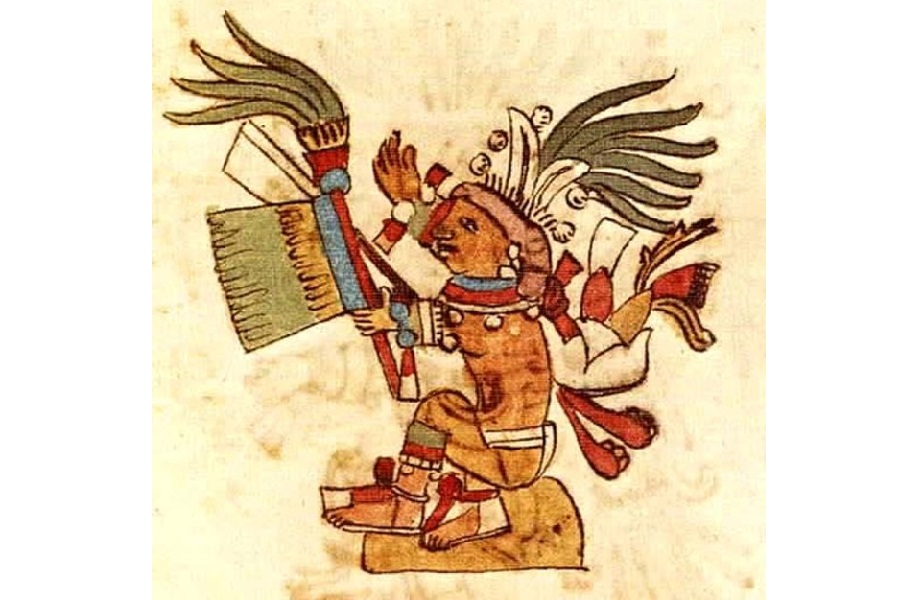
Parents: Tlazolteotl and Xochipilli
Nicknames: Maize Cob Lord, the Dried Ear of the Maize God
Aztec gods and goddesses often come in pairs, so it’s not surprising that there is another god of corn called Centeotl. While Aztecs believed many gods to be related to corn, Centeotl is normally considered to be the main one that actually took care of the corn. Others might have initiated the plant or spread it, but maintaining it is a whole different realm.
Although definitely an important god when thinking about corn, the importance of Centeotl was mostly seen in predating Mesoamerican cultures, like Olmec and Maya. Maintaining corn is important, but initiating was simply seen as more important by the Aztecs.
Tepeyollotli: The Heart of the Mountains
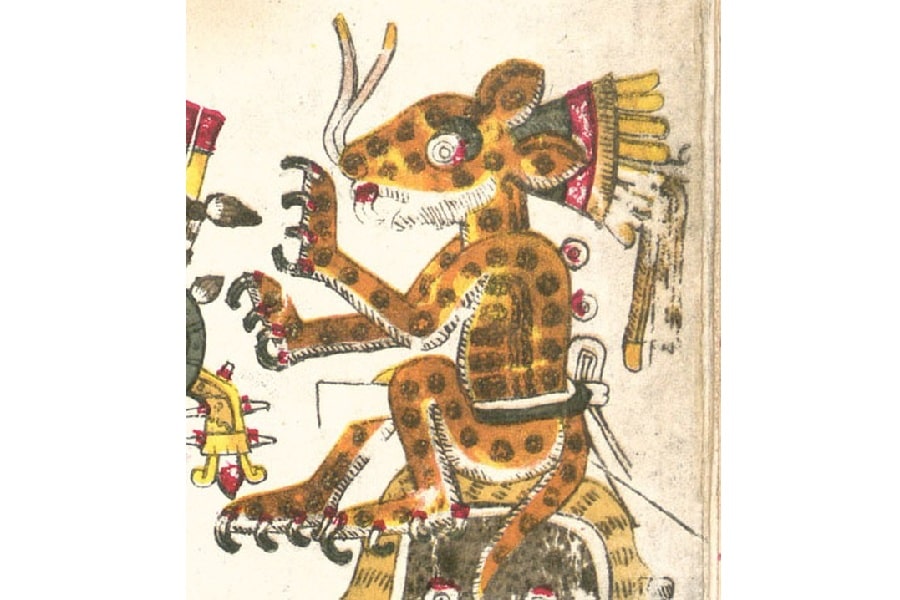
Nicknames: Heart of the Mountains
Aztecs, in case you weren’t aware of it yet, had a big thing for nature. From gods of the sun, wind, and rain, to gods of the earth itself, everything has its god, including the mountains. Tepeyollotl is his name, and he was the ruler of the darkened caves, earthquakes, echoes, and jaguars.
While many Aztec gods are two different animals or a human and an animal, Tepeyollotli is often depicted as a cat god, a jaguar in particular, in his full glory. A jaguar not only represented the king of the mountains, but also the brave warriors. Being depicted as such speaks to the perception of Tepeyollotli.
Xochiquetzal: The Goddess of Women’s Crafts
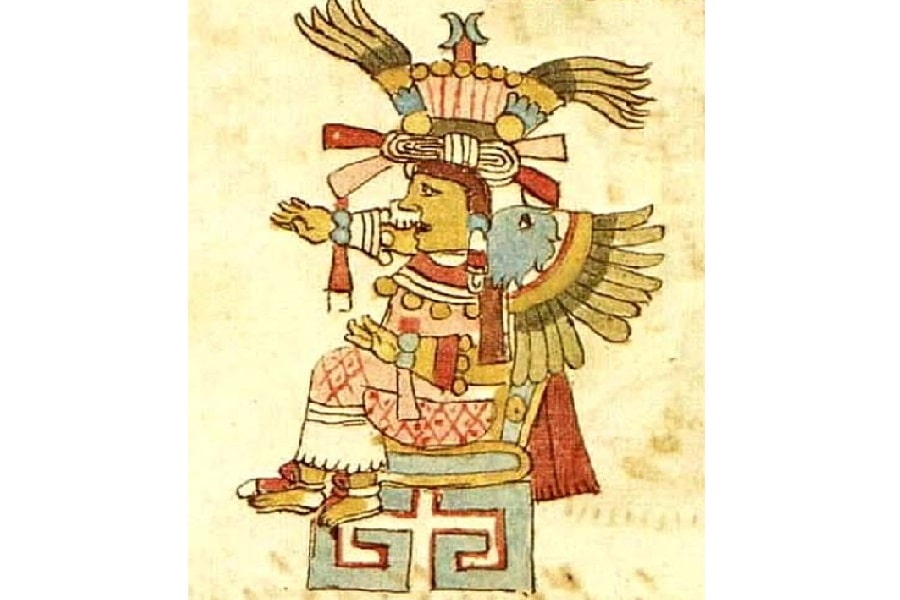
Other realms: Fertility, beauty, love, mothers, newborn babies
Nicknames: Ichpochtli, Xochiquetzalli, Xochtli, Macuixochiquetzalli
And last but not least is Xochiquetzal. She was a goddess associated with fertility, beauty, and love, and she served as the protector of young mothers. Xochiquetzal is one of the few goddesses always depicted as a young woman, which says quite a lot about the beauty standards of the ancient Aztecs.
By connotation, Xochiquetzal is also representative of human desire, pleasure, and excess, appearing also as patroness of artisans involved in the manufacture of luxury items.